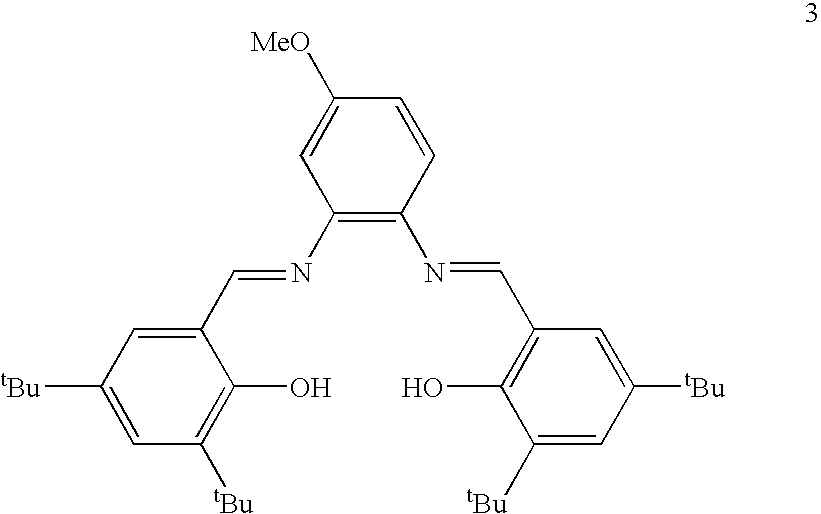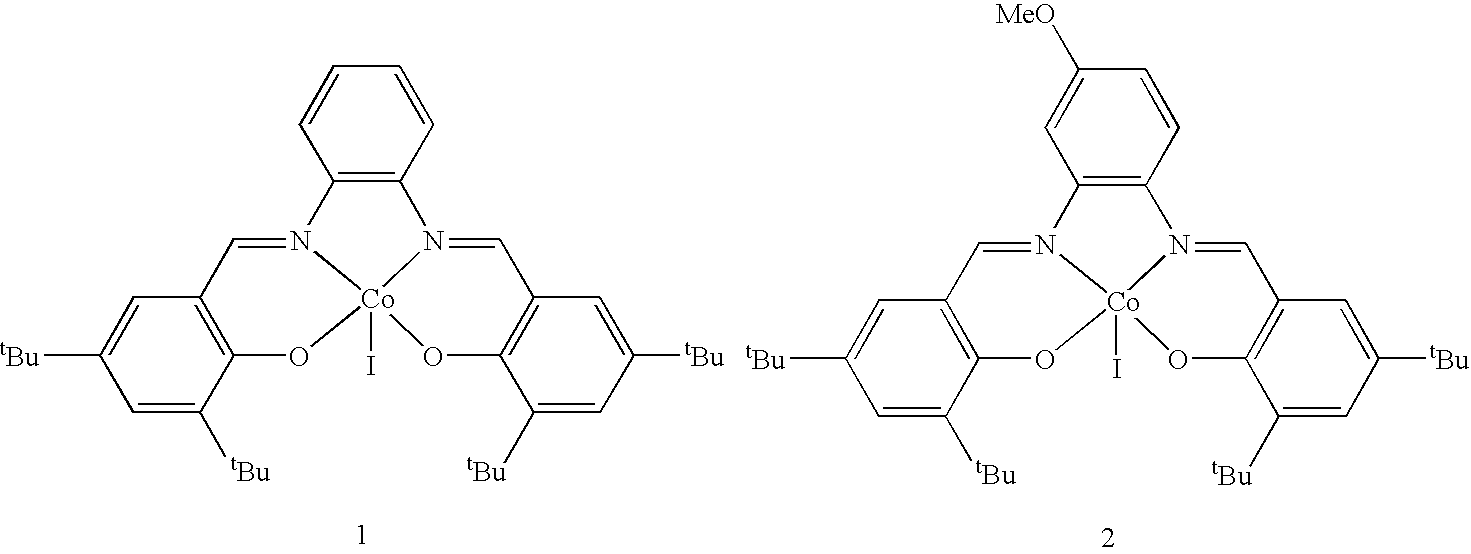Isotactic specific catalyst for direct production of highly isotactic poly (propylene oxide) or highly isotactic poly (butylene oxide)
a technology of isotactic specific catalyst and poly(propylene oxide) is applied in the direction of organic compound/hydride/coordination complex catalyst, physical/chemical process catalyst, metal/metal-oxide/metal-hydroxide catalyst, etc., which can solve the problem of high pdi, low mn, and inability to withstand dissolution. , to achieve the effect of low pdi and high mn
- Summary
- Abstract
- Description
- Claims
- Application Information
AI Technical Summary
Benefits of technology
Problems solved by technology
Method used
Image
Examples
example i
Preparation of (Salph) Co
[0039]N,N′-bis-(3,5-di-tert-butylsalicylidene)-1,2-phenylenediaminocobalt (1). Under nitrogen, degassed ethanol (150 mL) was added to a flask charged with a Teflon-coated stir bar, N,N′-bis-(3,5-di-tert-butylsalicylidene)-1,2-phenylenediamine (3.0 g, 5.5 mmol) and cobalt(II) acetate tetrahydrate (0.98 g, 3.9 mmol). The flask was heated to 80° C. for 20 minutes and then cooled to 22° C. Solvent was removed by vacuum filtration in air and solids were washed with methanol. The dark red powder was recrystallized by dissolving it in methylene chloride (30 mL) and layering with hexanes (700 mL), followed by cooling to 0° C. After 24 h, dark red crystals of 1 were obtained and isolated by vacuum filtration (2.3 g, 98% yield). IR (KBr cm−1): 2960, 2873, 1575, 1523, 1465-1359, 1260. Crystallographic data (solid state structure, shown below): triclinic, a=9.2149(3) Å, b=12.9485(5) Å, c=14.3796(6) Å, α=107.645(2)°, β=93.624(2)°, γ=95.851(2)°, V=1618.5(1) Å3, space grou...
example ii
Preparation of (Salph) Co OAc
[0040](N,N′-bis-(3,5-di-tert-butylsalicylidene)-1,2-phenylenediaminocobalt acetate (2). To a 200 mL beaker charged with a Teflon stirbar, 1 (1.00 g, 1.67 mmol) dissolved in methylene chloride (10 mL), and acetic acid (0.100 mL, 1.75 mmol) was added and the solution stirred open to air while solvent was allowed to evaporate, yielding a bright red powder. The powder, 2, was washed with pentane and dried in vacuo for 12 h (1.1 g, 97% yield). IR (KBr cm−1): 2967, 2876, 1613, 1580, 1524, 1490-1361, 1252.
[0041]To make (salph) CoBzOAc, an equimolar amount of benzylacetic acid is substituted for the acetic acid.
[0042]To make (salph) CoNpOAc, an equimolar amount of naphthlacetic acid is substituted for the acetic acid.
[0043]To make (salph) CoOMe, an excess amount of methanol is substituted for the acetic acid and dissolution in methanol is substituted for dissolution in methylene chloride.
example iii
Preparation of (Methoxy Salph) Co OAc
[0044]Compound 3 is depicted below.
[0045]
Compound 3 was prepared as set forth below.
Preparation of 3:
[0046]In a 100 mL round bottom flask equipped with Teflon stirbar, 3,5-di-tert-butyl-2-hydroxybenzaldehyde (1.47 g, 6.27 mmol) was added to 4-methoxy-1,2-phenylenediamine (0.433 g, 3.14 mmol) dissolved in THF (10 mL). Ethanol (40 mL) was added and the solution stirred at 24° C. A reflux condenser was then attached to the flask and it was heated to 95° C. for 18 h. The reaction was allowed to cool to 24° C. The solution was concentrated to 20 mL, causing solids to precipitate. Solids were filtered and washed with cold ethanol to give a yellow / orange solid (0.424 g, 23.7%).
[0047]Compound 3 was converted to (methoxy salph) Co, Compound 4, as follows:
Preparation of 4:
[0048]3 (0.400 g, 0.701 mmol) and cobalt acetate tetrahydrate (0.124 g, 0.498 mmol) were combined in a 50 mL round bottom flask. Under N2, degassed ethanol was added and stirred at 24° C....
PUM
| Property | Measurement | Unit |
|---|---|---|
| PDI | aaaaa | aaaaa |
| temperature | aaaaa | aaaaa |
| temperature | aaaaa | aaaaa |
Abstract
Description
Claims
Application Information
 Login to View More
Login to View More - R&D
- Intellectual Property
- Life Sciences
- Materials
- Tech Scout
- Unparalleled Data Quality
- Higher Quality Content
- 60% Fewer Hallucinations
Browse by: Latest US Patents, China's latest patents, Technical Efficacy Thesaurus, Application Domain, Technology Topic, Popular Technical Reports.
© 2025 PatSnap. All rights reserved.Legal|Privacy policy|Modern Slavery Act Transparency Statement|Sitemap|About US| Contact US: help@patsnap.com



